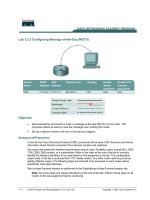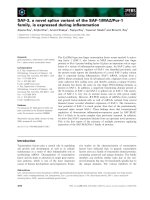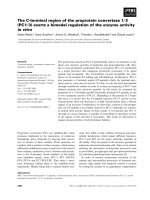4 4 3 alexander graham bell, teacher of the deaf
Bạn đang xem bản rút gọn của tài liệu. Xem và tải ngay bản đầy đủ của tài liệu tại đây (3.49 MB, 13 trang )
Suggested levels for Guided Reading, DRA,™
Lexile,® and Reading Recovery™ are provided
in the Pearson Scott Foresman Leveling Guide.
Alexander
Graham Bell,
Teacher of the Deaf
by Juna Loch
illustrated by Don Dyen
Genre
Historical
fiction
Comprehension
Skills and Strategy
• Character and
Setting
• Sequence
• Monitor and Fix Up
Scott Foresman Reading Street 4.4.3
ISBN 0-328-13465-1
ì<(sk$m)=bdegfg< +^-Ä-U-Ä-U
Reader Response
Alexander
Graham Bell,
1. The person telling the story is called the narrator.
Who is the narrator of this story? Explain how the
narrator feels about Alexander Graham Bell. Give
examples from the story to support your view.
Use a chart like the one below to organize your
thoughts.
Teacher
of the Deaf
Who is the narrator?
How does the narrator feel?
Examples:
2. Think back to a part of the story that was
confusing to you. How did you make sense of it as
you were reading? Explain what you did to figure
it out.
3. Look at the word apparatus on page 6. Using
context clues, what do you think apparatus
means? On a separate piece of paper, write your
own definition and a sentence using the word.
4. Bell’s dog says that his master’s interest in
Juna
Loch
everything was by
what
made
him a great inventor.
Do you agree
or disagree?
On a Dyen
separate piece
illustrated
by Don
of paper, explain your position. Give an example
from the book to support your point of view.
Editorial Offices: Glenview, Illinois • Parsippany, New Jersey • New York, New York
Sales Offices: Needham, Massachusetts • Duluth, Georgia • Glenview, Illinois
Coppell, Texas • Ontario, California • Mesa, Arizona
CONTENTS
CHAPTER 1
.....................
Can a Dog Talk?
4
.....................
Teaching the Deaf to Talk
7
CHAPTER 2
CHAPTER 3
....................
Teaching Electricity to Talk
12
....................
The Incredible Bell
21
The Failure That Worked .
22
CHAPTER 4
...........
Every effort has been made to secure permission and provide appropriate credit for
photographic material. The publisher deeply regrets any omission and pledges to
correct errors called to its attention in subsequent editions.
Unless otherwise acknowledged, all photographs are the property of Scott Foresman,
a division of Pearson Education.
ISBN: 0-328-13465-1
Copyright © Pearson Education, Inc.
All Rights Reserved. Printed in the United States of America. This publication is
protected by Copyright, and permission should be obtained from the publisher
prior to any prohibited reproduction, storage in a retrieval system, or transmission
in any form by any means, electronic, mechanical, photocopying, recording, or
likewise. For information regarding permission(s), write to: Permissions Department,
Scott Foresman, 1900 East Lake Avenue, Glenview, Illinois 60025.
2 3 4 5 6 7 8 9 10 V0G1 14 13 12 11 10 09 08 07 06 05
3
Chapter 1
Can a Dog Talk?
At first glance, this narrative may appear
as though it’s about the invention of the
telephone, but it’s really about a great man
who did wondrous things to help his fellow
human beings. This is also a story of me, a dog.
I am a Skye terrier, which is a handsome kind
of dog. My master, Alexander Graham Bell, or
Aleck, taught me to talk. Some people say this
is only a myth, but you can trust me. Dogs don’t
prevaricate (that means to tell lies).
Now, before we get to the telephone, we
have to go back to Scotland. This is where my
master, Aleck Bell, was born. A precocious and
inquisitive child, he was always interested in how
things work.
My master was very interested in vibrations.
There was a grand piano in his living room.
Aleck spent most of his time looking inside the
piano and fiddling around (no pun intended). He
noticed that different strings would buzz when
he played different notes. He tried to interest
me in it too, but I am a dog and naturally more
interested in activities like chasing rabbits.
4
5
Aleck was also curious about how our mouths
let us talk. He even constructed an apparatus
that was a model of the human mouth.
One day my master started moving my mouth,
so that I made the sounds “Ow-ah-oo, Ga-mama.” He called in the family to witness.
Once again, my master moved my mouth so
that I said, “Ow-ah-oo, Ga-ma-ma.”
“The dog asked, ‘How are you, Grandmama?’”
my master said.
Here I must set the record straight. I don’t
want you getting the wrong idea. I was not really
asking the ancient granny how she was feeling.
Unlike human beings, dogs do not spend their
days exchanging pleasantries and idle small talk.
My master made me make those sounds
because he was interested in how the throat and
mouth make human sounds. He wanted to put
that knowledge to an important use: to teach
deaf people how to speak. When he was only
twenty-four years old, he got his chance. He
arrived in Boston, Massachusetts, and took a job
teaching deaf people, which, from then on, he
always described as his life’s work.
6
Chapter 2
Teaching the Deaf to Talk
To teach deaf children to talk, my master used a
system his father had invented called Visible Speech.
If something is visible, it can be seen. Visible
Speech showed you where to position your teeth
and tongue to make any sound! My master and
his father showed this system to professors at
many colleges.
Now, my master Aleck thought that if hearing
people could use Visible Speech, then deaf
people could too.
He showed his deaf students how to make all
the different sounds. He taught them to move
their tongues to the back of their throats so they
could make a k sound. He showed them how to
open their mouths to say an a sound and how to
put their tongues to the backs of their teeth to
say t. There you have it, my least favorite word,
cat. His students could not hear that they had
done it right, but they could all say cat.
7
“What does this have to do with the
telephone?” I hear you questioning. Well, this is
part of the reason my master, Alexander Graham
Bell, invented the telephone.
I want you to understand and appreciate my
master the way I do. He did not think that the
most important thing he ever did was to invent
the telephone. He thought that teaching the
deaf was more important.
Wanting to find an even better way to help
his deaf students than using Visible Speech, my
master built another human mouth. This time,
the mouth measured the vibrations from speech.
(Remember how interested he was in vibrations!)
Students could now measure the sounds they
were making. My master also built a model of
the human ear. He worked like a dog, and—you
know me—I do not use that term lightly. But
he still had questions that needed answers and
problems that needed solutions.
8
9
Back in 1871, if you wanted to communicate
with someone far away, you could only send a
message along a wire using a kind of code on a
machine called a telegraph.
By the 1870s, people knew that sound is made
by vibration. If you strike an object in any way, it
vibrates. The amount an object vibrates is called
its “natural frequency.” Some objects vibrate a
lot, while other objects vibrate a little. But here’s
something amazing: if you put two objects that
vibrate the same amount near each other and
strike one, the other object will vibrate too! My
master thought these vibrations might be the
key to making a telephone.
How would this help Aleck make a telegraph
that could send more than one message at a
time? My master did an experiment, attaching
thin pieces of metal, or reeds, with different
vibrations to a telegraph. Each reed could carry
one message.
Could that message be picked up by another
reed on the other end of the wire? My master
thought so. He thought that the messages from
the different reeds would travel together on the
same wire. Each message would be picked up by
a reed with the same natural frequency on the
other end of the wire! My master called this idea
the Harmonic Telegraph. Harmonic has to do
with harmony, which means “together.”
10
11
Chapter 3
Teaching Electricity to Talk
Now if my master Aleck had not experimented
with his piano as a boy, he would not have
known about vibrations. If he had not known
about vibrations, he would not have tried to
make the Harmonic Telegraph. And if he had not
been working on the Harmonic Telegraph, he
could not have made the mistake that led to the
telephone.
It’s all tied up together, you understand. And
if my master Aleck had not been so interested in
everything, he would not have starting thinking
about a speaking telegraph!
12
“Do you know how the voice works, my dear
dog?” my master asked me one cold March day.
“When a person talks,”
my master explained, “the
sound is made by air. As you
breathe air out forcibly, the
air passes through a structure
called the voice box. The
voice box vibrates, pushing
the air together and creating
little waves of sound. These
Air coursing through
sound waves travel through
our voice box creates
the air until they reach an
sound.
ear. There, they strike
the thin skin of what’s
called your eardrum.
The eardrum tells your
brain what it hears. Then,
you hear it! Isn’t that
wonderful?”
I nuzzled his hand.
“If we could only make
electricity talk!” he said. I
didn’t really understand;
Sound waves reach
but then, these things are
the ear.
rather complicated for
dogs, after all.
13
My master did not know how to make
electricity speak. So he got a helper—a man
named James Watson.
One day, they were working on the Harmonic
Telegraph. “I want to make a speaking
telegraph,” my master told Watson.
“The voice isn’t strong enough to carry very
far,” Watson replied thoughtfully. “How will we
get it to move through the wires for miles across
country?”
“The tiny eardrum is as thin as tissue paper,”
my master answered. “But it can move the bones
of the inner ear. When that happens, we can
hear.” My master sighed. “If a tiny eardrum can
move sound, surely we can find some way to do
it too!”
I knew that a human voice could make me
move to fetch a stick or run after a ball. And the
human voice—even heard at a great distance—
could certainly make me come in to dinner! If
it could do all that, and more, maybe there was
hope for my master and his experiments.
14
15
But hold on, because things are about to get
really exciting. On June 2, a mistake allowed my
master to see—well, what should I call it?—a
miracle.
On that day, my master was in one room
and Watson was in another, fiddling with the
Harmonic Telegraph. I lay by his feet hoping he
would scratch my head.
Suddenly, my master came flying out of the
other room! He was breathless with excitement.
“What did you do, Watson?” he cried. “Wait—
don’t touch anything!”
16
We stared at him in amazement. When
Watson had plucked at a telegraph reed, my
master had heard its sound, rather than the
coded signal it made. What’s more, he knew
exactly what it was he was hearing. If he had not
been a musician, he would have missed it.
He also knew what it meant. Something as
small as that plucked reed could carry a sound.
That proved that the human voice could send
sound over a wire too! By the following spring,
Watson and my master had made a working
telephone! He rushed to
the Patent Office in
Washington, D.C., to get
a patent, which gives you
ownership rights to an
idea. He got there just a
few hours before another
scientist, Elisha Gray, who
claimed to have invented
the telephone too.
17
The telephone my master patented had two
parts. There was a transmitter, which turns your
voice into an electrical current. There was also
a receiver. This receives the current and turns it
into air waves. The transmitter was made of a
small capsule filled with carbon grains. It was
covered with a thin aluminum skin or membrane.
When my master spoke into it, the membrane
vibrated. When he spoke loudly, the grains of
carbon moved close together. When he spoke
softly, they were loose. Because the grains moved
around, they created the different currents my
master said he needed.
Inventing a telephone was exciting, but I,
for one, was ready to take a break and chase
cats. My master, however, couldn’t seem to stop
working. He was still interested in everything!
18
19
Chapter 4
The Incredible Bell
Three years after he invented the telephone,
my master created a phone that worked by
sending sound on beams of light! He called
this a “photophone.” Of course, dogs don’t use
phones, but it made humans very excited.
Now my master was famous and very rich. But
he still spent his time and his money finding ways
to better people’s lives. Whenever people asked
him what he did for work, he always said, “I’m a
teacher of the deaf.” Helen Keller, who was deaf
and blind and couldn’t speak, wrote a book and
dedicated it to him. He was very proud. So was I,
even though she didn’t mention my name in the
book.
20
In 2002, the U.S. Congress voted to give the
credit for the first telephone to Antonio Meucci,
an Italian-American who discovered the principle
of the telephone in 1849 but who could not
afford to patent his idea. Alexander Graham Bell
received the first patent in 1876.
Bell still helped make the twentieth century
incredible in many ways. He invented an
elaborate device called an iron lung, which
helps sick people breathe. He improved the
phonograph, and he invented a machine called
an audiometer to test hearing. Guess what?
When we measure sound, we measure it in units
called bels or decibels. They are named after Bell!
Bell remained, to the end, a man interested in
everything. Along with inventing and teaching,
he was also the first president of the National
Geographic Society. He helped to make the
magazine National Geographic into something
colorful and fun for everyone to enjoy.
21
22
The Failure That Worked
Reader Response
In 1888, to the nation’s horror, someone
shot two bullets into President James Garfield.
Amazingly, the President lived for weeks
afterwards. A team of doctors tried to remove
the bullets.
No one had x-rays back then, so no one knew
where the bullets were. Alexander Graham Bell
believed that he could help his President. Since
the bullet was made of metal, he thought he
could use a telephone rigged with magnetic coils
to find it! He was sure the device would make a
sound as it neared the bullet. He rushed down
to Washington to try and save Garfield. His tests
were inconclusive, though, and Garfield died a
few weeks later.
Afterward, Bell learned that his wasn’t the
only new invention in the President’s bedroom
that day. The President had been lying on a new
steel-springed mattress. The steel springs
were what Bell’s
magnet had
found!
1. The person telling the story is called the narrator.
Who is the narrator of this story? Explain how the
narrator feels about Alexander Graham Bell. Give
examples from the story to support your view.
Use a chart like the one below to organize your
thoughts.
Who is the narrator?
How does the narrator feel?
Examples:
2. Think back to a part of the story that was
confusing to you. How did you make sense of it as
you were reading? Explain what you did to figure
it out.
3. Look at the word apparatus on page 6. Using
context clues, what do you think apparatus
means? On a separate piece of paper, write your
own definition and a sentence using the word.
4. Bell’s dog says that his master’s interest in
everything was what made him a great inventor.
Do you agree or disagree? On a separate piece
of paper, explain your position. Give an example
from the book to support your point of view.









